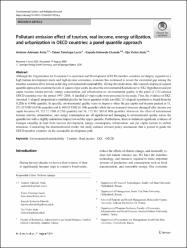Pollutant emission effect of tourism, real income, energy utilization, and urbanization in OECD countries: a panel quantile approach
Abstract
Although the Organization for Economic Co-operation and Development (OECD) member countries are largely regarded as a high human development index and high-income economies, evidence has continued to reveal the existential gap among the member countries drive toward achieving environmental sustainability. Giving this motivation, this research employed a panel quantile approach to examine the role of square of per capita income (the environmental Kuznets curve-EKC hypothesis) and per capita income, tourist arrivals, energy consumption, and urbanization on environmental quality in the panel of (31) selected OECD countries over the period 1995-2016. A handful of vital results were presented in the study. First, the evidence of EKC (invertedU-shaped) proposition is establish just for the lower quantiles while a no EKC (U-shaped) hypothesis is found from the 0.25th to 0.90th quantile. In specific, environmental quality starts to improve when the per capita real income peaked at 11, 271.13 USD (0.05th quantile) and 8, 604.15 USD (0.10th quantile) while the environment becomes damaged after income per capita becomes 89, 321.72 USD (0.25th quantile) and 36, 315.50 USD (0.50th quantile). Moreover, the effect of international tourism arrivals, urbanization, and energy consumption are all significant and damaging to environmental quality across the quantile but with a slightly minimized impact toward the upper quantile. Furthermore, there is statistical significant evidence of Granger causality at least from tourism development, energy consumption, urbanization, and per capita income to carbon emissions. Considering the aforementioned results, the study outlined relevant policy mechanism that is poised to guide the OECD member countries on the sustainable development path.
Collections
The following license files are associated with this item:


















